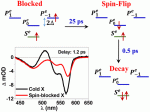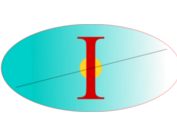Citation:
| ghosh2019spin.pdf | 1.39 MB |

Abstract:
The conjecture that, as in bulk semiconductors, hot multiexcitons in nanocrystals cool rapidly to the lowest available energy levels is tested here by recording the effects of a single cold “spectator” exciton on the relaxation dynamics of a subsequently deposited hot counterpart. Results in CdSe/CdS nanodots show that a preexisting cold “spectator exciton” allows only half of the photoexcited electrons to relax directly to the band-edge. The rest are blocked in an excited quantum state due to conflicts in spin orientation. The latter fully relax in this sample only after ∼25 ps as the blocked electrons spins flip, prolonging the temporal window of opportunity for harvesting the retained energy more than 100 fold! Common to all quantum-confined nanocrystals, this process will delay cooling and impact the spectroscopic signatures of hot multiexcitons in all envisioned generation scenarios. How the spin-flipping rate scales with particle size and temperature remains to be determined.



